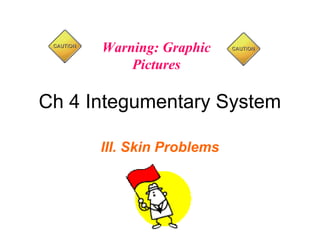
Ch 4 skin problems
- 1. Warning: Graphic Pictures Ch 4 Integumentary System III. Skin Problems
- 2. Skin Problems – infections, allergies, or damages A. Athlete’s Foot – mostly from fungal infection
- 3. B. Boils & Carbuncles Bacterial infection & inflammation of hair follicle. – Boil = 1 – Carbuncle = several connected boils
- 4. C. Black & Whiteheads 1. Blackheads - oil and dead skin cells trapped in a oil pore, makeup 2. Whiteheads - flesh-or white-colored bumps due to skin pore blockage; blockage is deeper than blackhead (covered w/epithelium)
- 5. D. Cold Sores 1. Caused by Herpes simplex virus I 2. Common, contagious, incurable
- 6. E. Contact Dermatitis 1. Inflammatory response – red, itchy rash 2. Non-contagious 3. Chronic – long term, reoccuring 4. Caused by contact with allergens or irritants, exposure to sunlight, or by poor circulation, even stress.
- 7. F. Impetigo 1. Crusting skin infection 2. Caused by staph and strep bacteria 3. Pus filled blisters 4. Highly contagious
- 8. G. Psoriasis 1. Chronic – arms, knees, elbows, scalp 2. Red patches covered with white scales 3. Unknown cause; some think autoimmune disorder 4. Triggered by trauma, infection, stress
- 9. H. Cyanosis 1. Blue skin, membranes, and/or nails 2. Due to reduced oxygen in blood
- 10. I. Burns 1.Tissue damage and cell death caused by heat, electricity, UV radiation, or chemicals 2. Associated dangers a. Dehydration b. Electrolyte imbalance c. Circulatory shock
- 11. 3.Rules of Nines a. Way to determine the extent of burns b. Body is divided into 11 areas for quick estimate c. Each area represents ~ 9%
- 13. 4. Burns are CRITICAL if… 1. Over 25% of body has 2nd degree 2. Over 10% has 3rd degree 3. 3rd degree burns on face, hands, and/or feet Electrical Contact Burn Heat Burn Scald Burn Chemical Sunburn Inhale Burn
- 14. J. Skin Cancer 1. Abnormal cell mass a. Benign -does not spread (encapsulated) b. Malignant -Metastasized (moves) to other parts of body Skin cancer is most common type of cancer.
- 15. 2. Three common types of Malignant Skin Cancer a. Basal cell carcinoma - least malignant - Most common - Arises from stratum basale b. Squamous Cell Carcinoma - arises from stratum spinosum - Metastasizes to lymph nodes - Early removal allows a good chance of cure
- 16. c. Malignant Melanoma - Most deadly - Cancer of melanocytes - Metastasizes rapidly to lymph & blood vessels - Detection uses ABCD rule.
- 17. ABCD Rule A = Asymmetry – Two sides of pigmented mole do not match B = Border irregularity – Borders of mole are not smooth C = Color – Different colors in pigmented area D = Diameter – Spot is larger then 6 mm in diameter